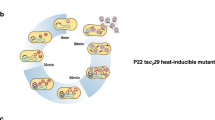Abstract
In Escherichia coli in vitro constructions of perfect palindromes larger than 30 base pairs (bp) long have in general been unstable1–8. A perfect palindrome has the unique possibility of forming a cruciform structure, and it is this feature which probably results in its instability. Negative supercoiling favours the formation of the cruciform conformation, which in turn causes the molecule to relax1,2. This relaxation may render replicons containing large perfect palindromes inviable4. An alternative hypothesis for inviability has been that the cruciform interferes with replication by favouring strand switching by polymerase I9. Here we show that the simultaneous absence of two recombination nucleases, the recBC product, exonuclease V, and the sbcB product, exonuclease I, confers viability on a derivative of phage λ carrying a perfect palindrome of inverted repeat length 1,600 bases. This observation suggests a third hypothesis—that nucleolytic cleavage of the cruciform is responsible for the inviability of the phage. Such an activity has been shown in vitro for T4 exonuclease VII10.
This is a preview of subscription content, access via your institution
Access options
Subscribe to this journal
Receive 51 print issues and online access
$199.00 per year
only $3.90 per issue
Buy this article
- Purchase on Springer Link
- Instant access to full article PDF
Prices may be subject to local taxes which are calculated during checkout
Similar content being viewed by others
References
Gellert, M., Mizuuchi, K., O'Dea, M. H., Ohmori, H. & Tomizawa, J. Cold Spring Harb. Symp. quant. Biol. 43, 35–40 (1979).
Mizuuchi, K., Mizuuchi, M. & Gellert, M. J. molec. Biol. 156, 229–243 (1982).
Behnke, K., Malke, H., Hartmann, M. & Walter, F. Plasmid 2, 605–615 (1979).
Lilley, D. M. J. Nature 292, 380–382 (1981).
Collins, J. Cold Spring Harb. Symp. quant. Biol. 45, 409–416 (1981).
Collins, J., Volckaert, G. & Nevers, P. Gene 19, 139–146 (1982).
Hagan, C. & Warren, G. Gene 19, 147–151 (1982).
Sadler, J. R. et al. Gene 3, 211–232 (1978).
Bolivar, F. et al. Proc. natn. Acad. Sci. U.S.A. 74, 5265–5269 (1977).
Mizuuchi, K., Kemper, B., Hays, J. & Weisberg, R. Cell 29, 357–365 (1982).
Horii, Z. I. & Clark, A. J. J. molec. Biol. 80, 327–344 (1973).
Stahl, F. W. et al. Virus Research (eds Fox, C. F. & Robinson, W. S.) 487–503 (Academic, New York, 1973).
Kushner, S., Nagaishi, H., Templin, A. & Clark, A. J. Proc. natn. Acad. Sci. U.S.A. 68, 824–827 (1971).
Bachman, B. J. Bact. Rev. 36, 525–557 (1972).
Templin, A., Margosian, L. & Clark, A. J. J. Bact. 143, 590–596 (1978).
Kobayashi, I. & Ikeda, H. Molec. gen. Genet. 153, 237–245 (1977).
Sternberg, N., Tiermeier, D. & Enquist, L. Gene 1, 255–280 (1977).
Author information
Authors and Affiliations
Rights and permissions
About this article
Cite this article
Leach, D., Stahl, F. Viability of λ phages carrying a perfect palindrome in the absence of recombination nucleases. Nature 305, 448–451 (1983). https://doi.org/10.1038/305448a0
Received:
Accepted:
Issue Date:
DOI: https://doi.org/10.1038/305448a0
This article is cited by
-
Delineating the mechanism of fragility at BCL6 breakpoint region associated with translocations in diffuse large B cell lymphoma
Cellular and Molecular Life Sciences (2024)
-
Excision of Unstable Artificial Gene-Specific Inverted Repeats Mediates Scar-Free Gene Deletions in Escherichia coli
Applied Biochemistry and Biotechnology (2015)
-
Production of first generation adenovirus vectors: a review
Gene Therapy (2000)
-
Overproduction of the ATP-dependent nuclease AddAB improves the structural stability of a model plasmid system inBacillus subtilis
Molecular and General Genetics MGG (1995)
-
The nature of extra-chromosomal maintenance of transforming plasmids in the filamentous basidiomycete Phanerochaete chrysosporium
Current Genetics (1992)
Comments
By submitting a comment you agree to abide by our Terms and Community Guidelines. If you find something abusive or that does not comply with our terms or guidelines please flag it as inappropriate.



